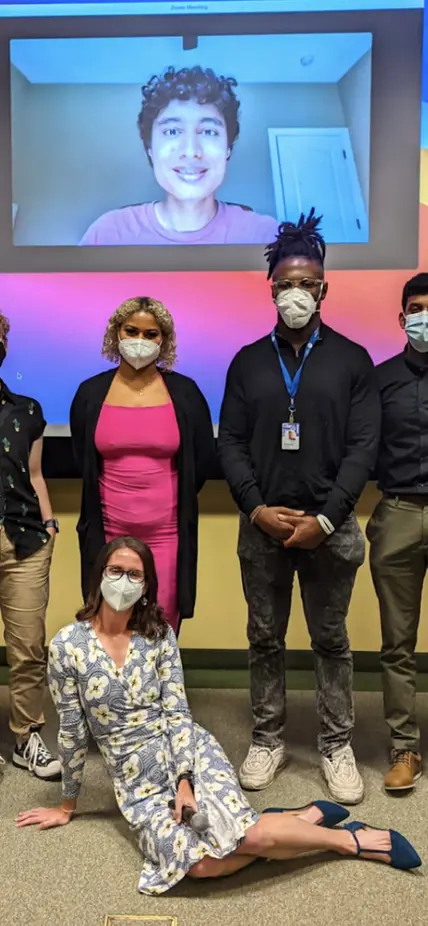The first year of the Earth and Planets Laboratory’s (EPL) Summer Undergraduate Research Program (SURI) ended on August 5, 2022, after ten weeks of intensive hands-on research, field trips, and professional development workshops. The interns closed out the summer with an impressive scientific symposium to share their summer research and celebrate a job well done!
“The level of science and the quality of the presentations was truly outstanding and is a testament to all of the work put in by our interns and their mentors,” stated Michael Walter, the Director of EPL.
Short talks are a typical method for sharing new research results, so the symposium added to the interns’ authentic practice of being a scientist. Many of the attendees were also impressed as these college undergrads fielded questions from the audience like pros.
Below is an overview of their presentations and their research this summer:
Eran Driscoll
Eran Driscoll joined us from The College of William and Mary, where he is pursuing a geology and physics double major. Driscoll was the first to present their talk. He worked with Emma Bullock, Michelle Jordan, Timothy Mock, Suzy Vitale, Jianhua Wang, Cian Wilson, and Jing Yang to dig into laboratory analysis and the characterization of planetary materials. During the summer, Driscoll gathered information from two different meteorites—Gibeon and NWA 4759—to discover more about the formation of our Solar System.
Maura Clark
Maura Clark joined us from the University of Maryland, where they are pursuing an astronomy and physics double major. This summer, Clark worked with Shaunna Morrison to create a large dataset of ungrouped chondritic meteorites to answer the question, "is the current classification scheme broad enough to encompass all chondritic meteorites?"
Chondrites are meteorites that are made from materials that can predate our Solar System. Analyzing their isotopes helps us understand where and how the chondrites were formed and lets us piece together the early history of our Solar System and planetary formation.
Clark used sophisticated data analytics to probe this question, and while more research is needed, they are well on their way to developing an all-encompassing chondritic classification scheme!
Nadyah Abdul-Majid
Nadyah Abdul-Majid joined us from Howard University, where she is pursuing a chemistry major with a mathematics minor.
This summer, she worked with Dionysis Foustoukos to study the isotopic evolution of altered insoluble organic matter (IOM) in chondritic meteorites. She was interested in investigating whether the pH of the IOM’s environment impacted the exchange of Deuterium—one of the two stable isotopes of Hydrogen—to Hydrogen following the proposed kinetics of their reference model.
She discovered that alcohol functional groups can enhance Deuterium exchange because they are more abundant under alkaline conditions and lower temperatures.
Anirudh Hari
Anirudh Hari, presenting virtually, zoomed into the symposium to discuss his summer project, in which he worked with Tim Strobel and Samuel Dunning to synthesize diamond nanothreads. He wanted to see if we could make carbon nanothreads from larger molecules than normal and control their synthesis in the lab. Hari joined the program from Johns Hopkins University, where he just completed a Bachelor’s in Physics.
"We're still pretty far away from getting to make a space elevator or flexible armor,” said Hari, “but we're getting better at regulating these predicted chemical pathways."
Sarah Fong
Sarah Fong joined us from the University of Virginia, where she is a biochemistry major. She presented "Biochemistry of Chemosynthetic Life: Microorganisms Behavior at Different Pressures." This summer, she worked with Dionysis Foustoukos to study the physiology of Nautilia abyssi—a high-pressure thermophilic microbe that has been isolated from deep-sea hydrothermal vents.
She found that N. abyssi is actually piezeotolerant—i.e., it is tolerant of high pressures but prefers lower pressures! More research is needed to understand the physiology of these deep-sea microbes.
Shazali Audu
Shazali Audu presented "Modeling the HR 4796 Debris Disk.” Audu joined us from the University of Maryland, where he is an aerospace engineering major. This summer, he worked with Alycia Weinberger and former EPL postdoc Jessica Arnold to model the protoplanetary disk around the star HR 4796.
Debris disks are mostly made up of dust and gas, and they can tell us a lot about the formation environment of the star it surrounds. We can learn about them by observing how light reacts with dust grains. Audu’s modeling efforts focused on a more realistic model of these dust particles than has been applied in the past – turns out dust particles are more complicated than simple spheres! He determined that previous composition inferences about the disk around HR 4796 are likely incorrect, or at the very least incomplete.
Chris Anto
Rounding out the presentations was Chris Anto from Johns Hopkins University, where he is pursuing a physics and mathematics double major.
This summer, Anto worked with Zachary Geballe to study the Earth’s core through laboratory experimentation. In particular, he worked to validate the accuracy and precision of a newly designed temperature measurement system to study planetary cores here at the Earth and Planets Laboratory. Using samples that we already know the melting point of, Anto was able to test the new system.
"As we increase the energy input, we expect to see plateaus, and the plateaus represent melting."
He tested iridium, platinum, tungsten, and titanium. He found that the precision and accuracy for iridium, platinum, and titanium were good. However, tungsten, while still precise, continued to shift from its true melting point.
Congratulations to all of our interns, and good luck on the upcoming school year and all your future endeavors. We look forward to seeing what you accomplish— perhaps even as future scientists here at EPL!
Thank you to all of our scientific mentors, and a special thanks to Johanna Teske, who planned and ran this summer’s internship program in addition to her work as a Staff Scientist.
Are you interested in participating in our internship program? Please look out for announcements in late 2023 for application instructions!
